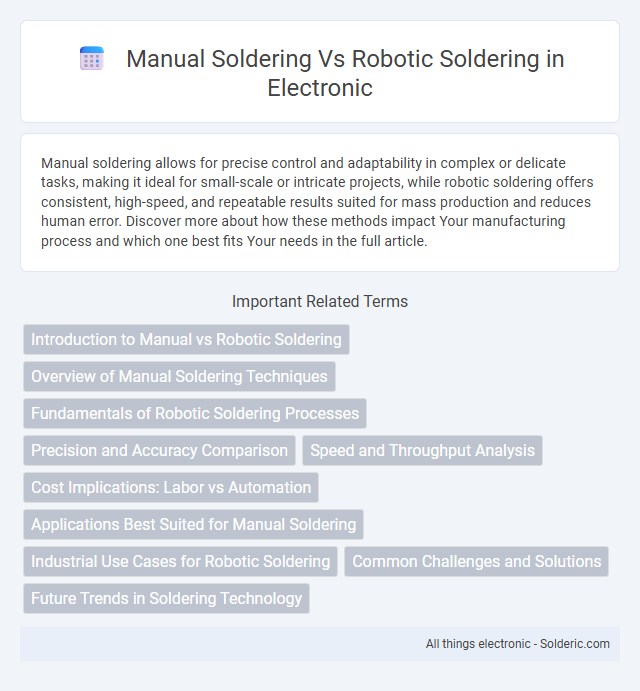Manual soldering allows for precise control and adaptability in complex or delicate tasks, making it ideal for small-scale or intricate projects, while robotic soldering offers consistent, high-speed, and repeatable results suited for mass production and reduces human error. Discover more about how these methods impact Your manufacturing process and which one best fits Your needs in the full article.
Comparison Table
| Feature | Manual Soldering | Robotic Soldering |
|---|---|---|
| Precision | Moderate; dependent on operator skill | High; consistent and repeatable |
| Speed | Slow; limited by human pace | Fast; optimized cycle times |
| Consistency | Variable; prone to human errors | Uniform; minimal variations |
| Cost | Low initial investment; higher labor costs | High initial investment; lower long-term labor costs |
| Flexibility | High; easily adaptable to various tasks | Moderate; requires programming for changes |
| Training | Extensive skill development needed | Requires programming and maintenance skills |
| Application | Small batches, prototypes, repairs | Mass production, high-volume assembly |
Introduction to Manual vs Robotic Soldering
Manual soldering offers precise control and flexibility, making it ideal for prototype development and small-scale production where human skill enhances quality. Robotic soldering excels in high-volume manufacturing by delivering consistent, repeatable joints with increased speed and reduced error rates. Your choice between manual and robotic soldering depends on production scale, complexity, and quality requirements.
Overview of Manual Soldering Techniques
Manual soldering techniques involve using handheld tools such as soldering irons or soldering guns to join electronic components with precision and control. Skilled operators rely on techniques like drag soldering, point-to-point soldering, and through-hole soldering to ensure robust electrical connections and minimize defects. Your expertise in controlling temperature and solder flow is critical for achieving high-quality results in sensitive electronic assemblies.
Fundamentals of Robotic Soldering Processes
Robotic soldering processes utilize programmable robotic arms equipped with precise temperature-controlled soldering tools to ensure consistent weld quality and minimize human error, enhancing production efficiency. These systems employ sensors and vision-guided technology to accurately position soldering tips, enabling repeatable and scalable operations ideal for high-volume manufacturing. The automation of heat application and solder feed mechanisms in robotic soldering optimizes thermal profiles and reduces defects commonly encountered in manual soldering practices.
Precision and Accuracy Comparison
Robotic soldering offers significantly higher precision and accuracy compared to manual soldering, utilizing programmed movements and consistent heat application to reduce errors and ensure uniform solder joints. Manual soldering depends heavily on the skill and steadiness of the technician, making it prone to inconsistencies and defects, especially in high-volume or fine-pitch applications. For your projects requiring meticulous detail and repeatability, robotic soldering provides a superior solution to achieve optimal quality control.
Speed and Throughput Analysis
Robotic soldering significantly outperforms manual soldering in speed and throughput, consistently delivering precise and repeatable joints at high volumes without fatigue. Manual soldering, limited by human dexterity and endurance, results in slower cycle times and variable quality, especially during large production runs. Your manufacturing efficiency can greatly benefit from robotic systems that optimize soldering processes to achieve faster turnaround and scalable output.
Cost Implications: Labor vs Automation
Manual soldering involves higher labor costs due to skilled technician wages and slower production rates, making it less cost-effective for large-scale manufacturing. Robotic soldering reduces labor expenses by automating repetitive tasks, increasing throughput, and minimizing human error, which lowers rework and scrap rates. Initial setup and maintenance costs for robotic systems are significant but are offset by long-term savings in labor and efficiency gains.
Applications Best Suited for Manual Soldering
Manual soldering is best suited for low-volume production, prototyping, and small-scale repair work where precision and adaptability are crucial. You can easily handle delicate components, complex assemblies, and custom modifications that require skilled craftsmanship. This method excels in electronics repair shops and artisan manufacturing environments where flexibility outweighs automation efficiency.
Industrial Use Cases for Robotic Soldering
Robotic soldering excels in high-volume industrial use cases such as automotive electronics, medical device manufacturing, and consumer electronics assembly, where precision and consistency are critical. Your production line benefits from increased throughput, minimized human error, and enhanced quality control through repeatable soldering processes. Industries demanding compliance with strict standards leverage robotic soldering to maintain reliability and scalability.
Common Challenges and Solutions
Manual soldering often faces challenges such as inconsistency in solder joints, operator fatigue, and limited precision, which can lead to defects and rework. Robotic soldering addresses these issues by providing uniform heat application, repeatability, and increased throughput, though it requires significant upfront investment and calibration to handle complex geometries. Your choice between manual and robotic soldering should consider factors like production volume, complexity of assemblies, and the need for consistent quality to optimize efficiency and reduce errors.
Future Trends in Soldering Technology
Future trends in soldering technology emphasize increased automation and precision, with robotic soldering systems integrating AI and machine learning for enhanced quality control and efficiency. Advances in sensor technology enable real-time monitoring and adaptive adjustments during the soldering process, reducing defects and material waste. Manual soldering remains relevant for prototyping and repair tasks, but scalable industries are rapidly adopting robotic solutions to meet higher production demands and maintain consistent results.
manual soldering vs robotic soldering Infographic

 solderic.com
solderic.com